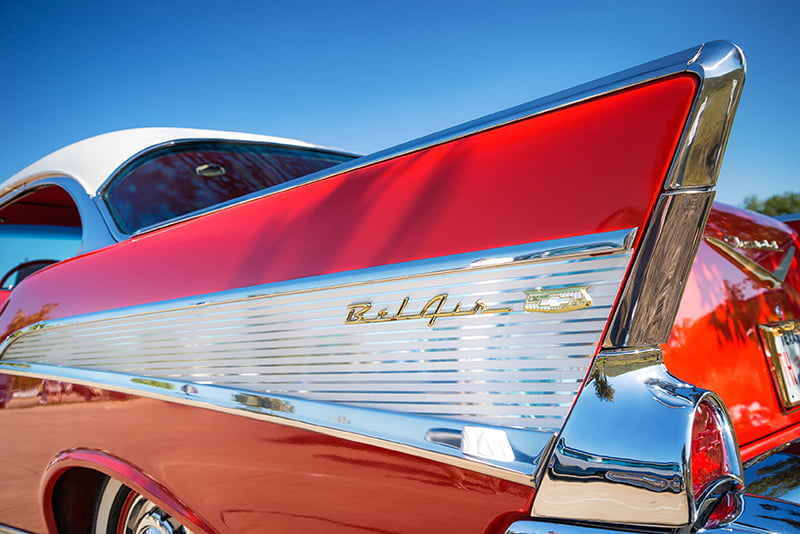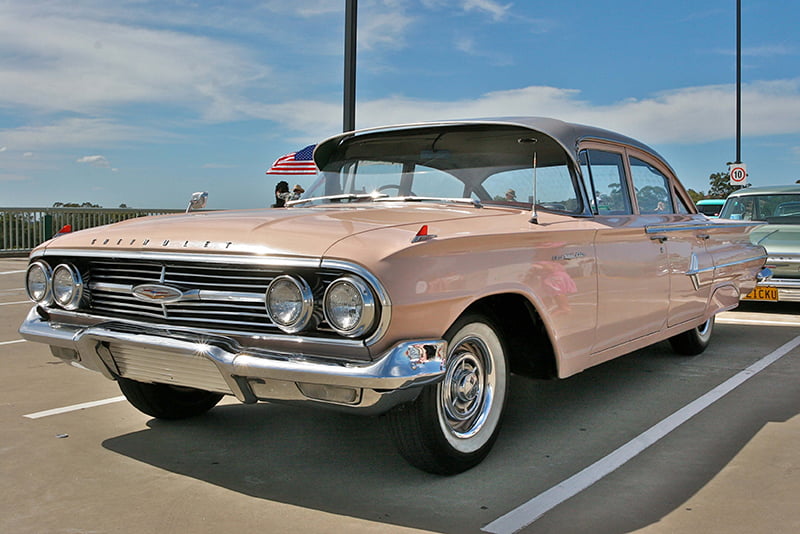Long considered to be the star attraction of the Chevrolet lineup, there’s many reasons why the Bel Air has managed to hold our attention for all these years.
It’s hard to believe that there was once a time where Chevrolet cars were the cheapest models on offer under the General Motors banner. Although Chevrolet once came last behind Pontiac, Oldsmobile, Buick and of course, Cadillac, many of those former powerhouse brands have since been retired thanks to unsustainable production methods and sales figures. Ironically, it’s Chevrolet that still stands, and the beloved Bel Air is one of the primary contributors to this.
 The Global Love For The Bel Air Lives On
The Global Love For The Bel Air Lives On
Marketed as “a car for every purse and purpose”, the Chevrolet brand went on to become the volume leader in the General Motors diverse family of automobile subsidiaries, selling mainstream vehicles designed to compete with the likes of the Ford Motor Company. The strategy worked, and Chevrolet went on to overtake Ford as America’s best selling car brand in 1929.
However, if there was ever a vehicle to all but define a generation, the Chevrolet Bel Air has all but secured the title for the era that was the fifties. When the war was over, the world rejoiced. Life was good, and just about everything tied to American pop culture during this era was regarded as big – think big hair, big skirts, big colours, and big cars, with one of the most iconic models being the Chevy Bel Air.
In 1950, Chevrolet debuted the iconic car that would set the tone of the American automotive market for the next few years, if not the decade. Models with similar characteristics to the Bel Air had previously failed to get any significant footing, but the Bel Air seemed to come in at just the right time. The initial production tested the waters of the revised concept, and the first generation of Bel Airs seemed to truly connect with the American public like no other.
While the success of the first generation of Bel Airs was certainly noteworthy, later models released in the middle of the decade saw these vehicles transform from Sunday morning cruisers to Saturday night staples. General Motors gave the second generation more than a few upgrades, which included a Ferrari style grille, chrome headliner bands for hardtops, chrome fender spears and stainless window openings – all in addition to the key characteristics of the original design. For the first time, the Chevy Bel Air also offered a V8 engine, with options including 3.5L I6, 3.9L I6, 4.3L V8, and 4.6L V8 engines for revheads and families alike.
However, right alongside Elvis, Marilyn Monroe and James Dean, it’s the 1957 Bel Air that is regarded as one of the most revered icons of the decade. While the models remained roomy, with tastefully restrained, period use tail fins and chrome, the engines were in a league of their own. Particularly relevant for the youth of the United States, there was nothing cooler than driving a Bel Air.
 Today, the Bel Air is regarded as one of the staples of the international classic car market. Whether it’s the size of their engines, their distinct use of chrome or tail fins, or even the bygone era that they represent, a Bel Air for sale today in Australia can set you back anywhere between $40,000 and $150,000. Well-maintained and preserved examples are highly sought after by car collectors and enthusiasts on a global scale, and this badge series is a prized and highly sought after symbol that represents a time when cars were works of art.
Today, the Bel Air is regarded as one of the staples of the international classic car market. Whether it’s the size of their engines, their distinct use of chrome or tail fins, or even the bygone era that they represent, a Bel Air for sale today in Australia can set you back anywhere between $40,000 and $150,000. Well-maintained and preserved examples are highly sought after by car collectors and enthusiasts on a global scale, and this badge series is a prized and highly sought after symbol that represents a time when cars were works of art.
How To Get Your Hands On A Classic Car
Finding a fellow vintage auto enthusiast can feel a bit like finding a needle in a haystack, but rest assured that Classic’s Garage understands the thrill more than most. Having spent forty years collecting anything and everything from matchbox cars to hub caps, he’s successfully followed his passion to source, collect and stock beautiful and low mileage classic automobiles from around the world. With extensive experience in the automotive industry, it was only a matter of time before Wayne expanded on his love of vintage, iconic vehicles to share his knowledge and passion with the public.
Although his passion is for automobiles built before 1978, with a particular love for Buicks, Cadillacs, Lincolns, Oldsmobiles and even Fords, Wayne is just as passionate about the stories of the owners. Just like the cars, he has found that his fellow classic car enthusiasts all have wildly different attractions and logic behind their passion or hobby, and this often translates into how the car is presented. If it’s even remotely different, rare or just plain unusual, Wayne will overcome the relevant logistical and geographical challenges of bringing the cars to his showroom in Australia.


 The Global Love For The Bel Air Lives On
The Global Love For The Bel Air Lives On